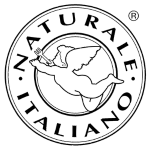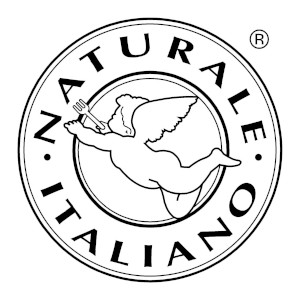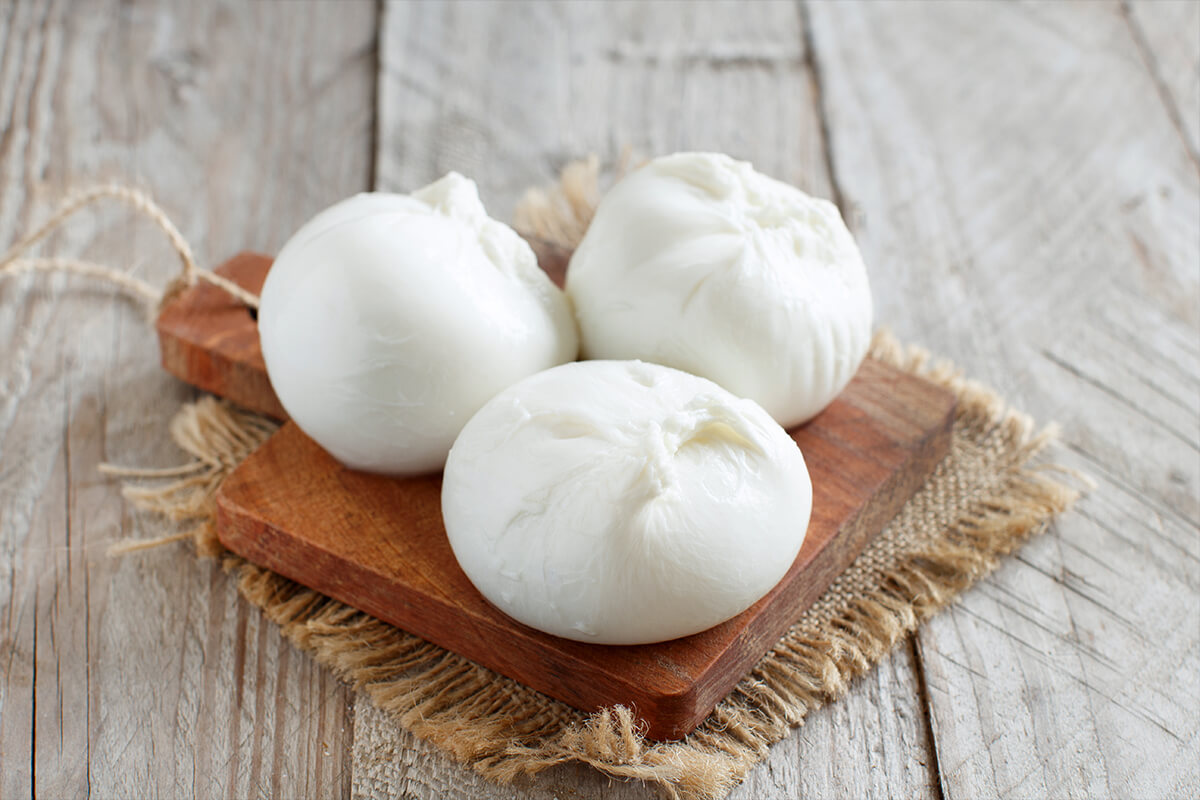If we were talking about soccer, they would be like Roberto Baggio and Paolo Maldini; talking about food, mozzarella and burrata are two of the most famous fresh cheeses in the world, more and more present in restaurant menus and on international tables.
Two products very similar to each other in appearance, but actually totally different; both are made of cow's milk and are processed with spun paste, maybe this is the reason why people think burrata is a sort of excellent version of mozzarella. In order to solve any doubt, let's see what are the main characteristics that distinguish these two Made in Italy excellences.
What is the difference between mozzarella and burrata?
First of all, these two products are produced in different areas of Italy. Mozzarella, also known as fior di latte, has a very long history and is produced in Campania, whereas burrata was born much more recently in Apulia.
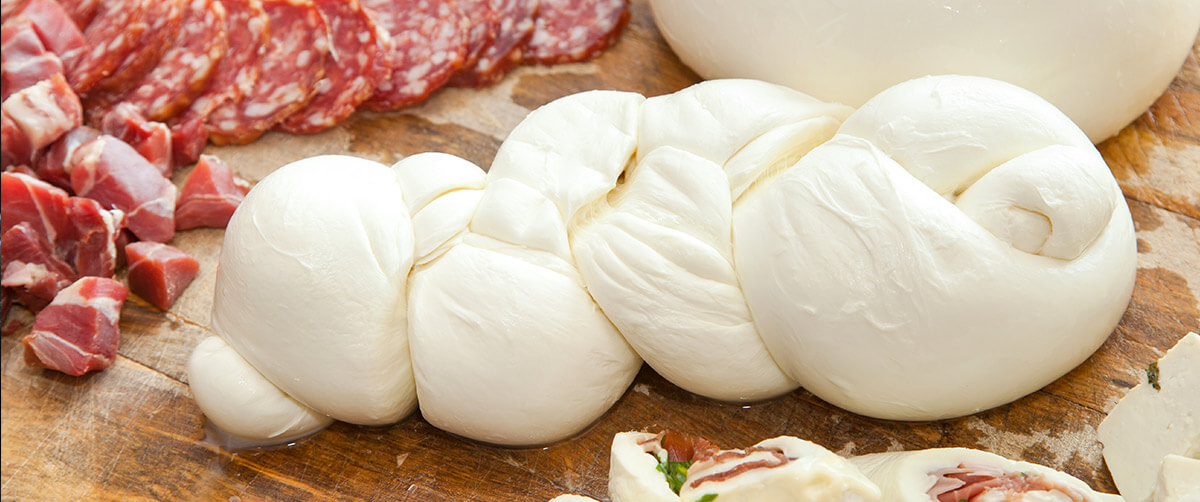
Mozzarella is a fresh pasta filata cheese, widely used in many typical Italian dishes such as pizza and caprese salad. It is produced by curdling pasteurized cow's milk (or buffalo), to which are added milk enzymes and rennet. This variant is recognized as a traditional guaranteed specialty, as well as STG. The curd is subsequently cut in strips and kneaded in boiling water in order to be spun and finally cut.
Mozzarella di Bufala Campana, which in the course of time has obtained the certificate of denomination of origin with European protection, is produced exclusively with buffalo milk coming from the provinces of Caserta and Salerno and from some municipalities near Naples, Benevento, Latina and Foggia. This is because only some territories have the ideal climatic conditions for the milk to reach certain quality requirements.
There are many sizes of Mozzarella di Bufala Campana, among the most famous ones there are Zizzona di Mondragone, treccia and bocconcini, as well as many variants, as the classic version, smoked or figliata.
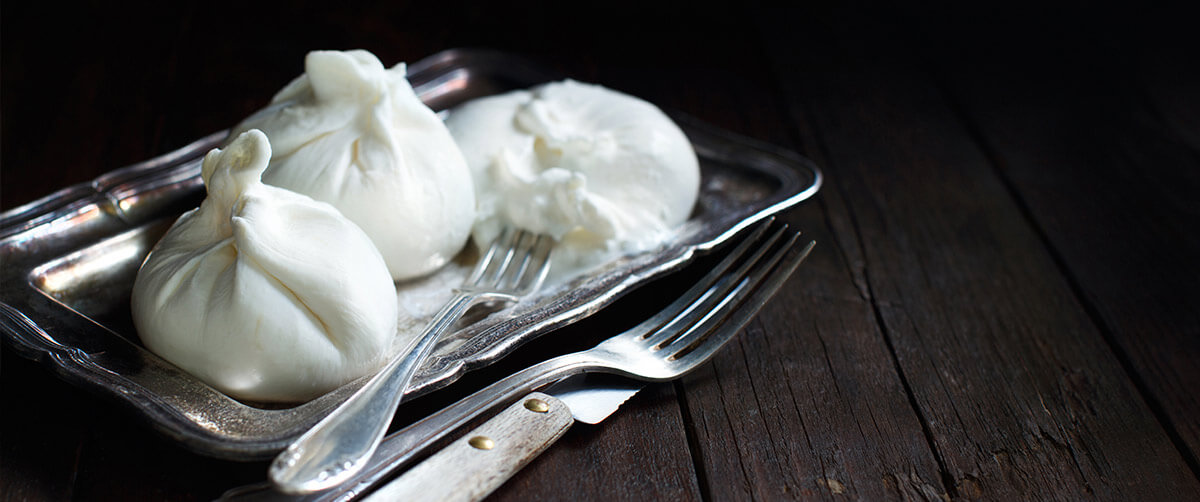
Burrata is produced in the eastern region of Apulia and differently from mozzarella it is much more compact, because it is entirely made of spun paste; it looks like a sort of casket which contains inside the cream of stracciatella. Hard outside but soft inside.
It is made of frayed pasta filata mixed with cream, which provides a creamy consistency similar to butter. The most prestigious and well-known Italian burrata is the one from Andria, which also boasts the IGP certification and can be produced only and exclusively by seven dairies in the area.
The production of burrata takes place throughout the year and it is entirely handmade, according to tradition. There are several steps to be followed in order to make a truly quality product, but we will discover them later.
Since we have already mentioned stracciatella, let's see what it is. It is easy to think that being the content of burrata is the same product, but in reality there are substantial differences between these two Italian excellences as well.
Mozzarella, burrata and...Stracciatella!
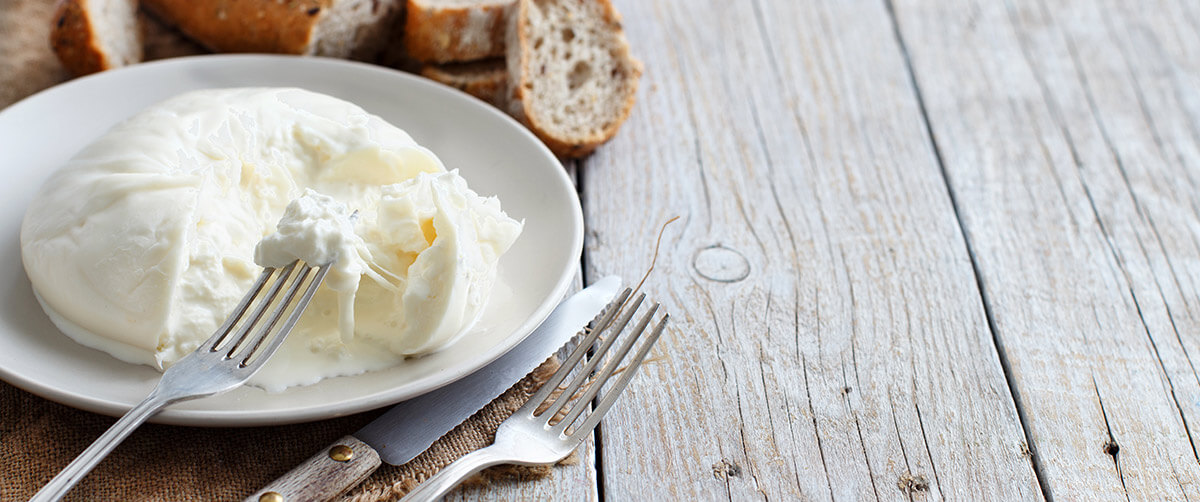
Stracciatella is a cheese without rind, straw-white in color and with a very smooth and creamy texture. Its taste is very tasty, delicate and sweet, especially when fresh and just packaged; it recalls the taste of milk and live milk enzymes.
It should be consumed within 24 hours from the purchase, as it does not contain preservatives and its taste changes with time, becoming more and more acid. As mentioned before, stracciatella is usually found inside burrata, however it is always easier to buy it as a single product to be used in many different recipes.
The processing method is strictly artisanal and based on tradition, which has been handed down from dairy to dairy for over 100 years.
Buffalo Burrata: for those who want more
Buffalo Burrata has its origins in Campania, it is a fresh and creamy cheese which should be consumed as soon as it is produced or at the most after a very short seasoning.
In appearance, it looks like a mixture of small pieces of buffalo mozzarella with a knob of butter inside. It is a spun paste cheese, obtained from the processing of buffalo's milk; in commerce it can be found in different shapes with a weight ranging from 300 to 400 g
The choice of the shape, which can be roundish or pear-shaped, depends on the dairy of production and is established before salting in brine. It is a very fat cheese, for this reason it is recommended to consume it occasionally: however it is rich in nutrients and vitamins which have beneficial effects on bone structure. Seen its nutritional properties, buffalo burrata can be an excellent second course to be served at the table, better if accompanied by seasonal vegetables and fruit
Let's take a look at some of the dishes that can be made with buffalo burrata and that reflect tradition:
- Buffalo burrata as a single dish, cut into round slices
- Mixed salad dressing, ideal for summer
- Bread bruschetta with burrata, cherry tomatoes and vegetables
- Battered Pumpkin Flowers Stuffed with Burrata Cheese
- Burrata-filled Pasta Dumplings
- Ravioli with scallops and burrata cheese
- Rustic aubergine, tomato and basil sauces
- Used for stuffing pies
As far as wine matching is concerned, buffalo burrata is perfect with red wines, especially young and sparkling ones.
How mozzarella is produced
- Pasteurisation of the milk, i.e. heating the raw milk in a boiler: this takes place at a temperature of 85°, dropping to 35° during processing.
- Afterwards, it is placed in boilers where rennet and cultures are added for the production of lactic acid and coagulation. The mixture is left to rest until the surface appears shiny and compact.
- Using a special tool similar to a whisk, called spino or lira, the curd is broken into many parts, which sink into the whey.
- After a few hours, the solid part is separated from the whey: the former (the curd) is placed in vats, the latter in other containers and used to make cream or ricotta.
- The curd is then placed on tables where the draining takes place: the liquid with which it was soaked is eliminated and goes to make up the whey for the next day's processing: the 'cizza'.
- The tables are placed in a room at a temperature of 45° with humidity of about 100% and the Ph is measured until the desired one is obtained.
- The curd is then passed through the stretching machine: a machine containing water at 85° which transforms it into a stringy paste.
- It is then cut into thin strips and minced and mixed again inside baskets, lifting and pulling the dough. It is cut, either manually or through the moulding machine, into many mozzarellas.
- They are transferred to the cooling room and are immersed in brine to achieve the right degree of salting.
- It is then packaged in sizes ranging from 20 grams to 800 grams.
How Burrata is produced
- Pasteurisation of the milk, i.e. heating the raw milk in a vat at a temperature of 35° - 37 °C.
- Acidification and fermentation of the milk in a natural way with selected ferments, starter milk or starter whey, or with food acids in order to obtain a pH around 6.1-6.2
- Coagulation of the milk through the addition of natural calf or vegetable microbial rennet, followed by the breaking up of the curd until grains the size of hazelnuts are obtained. A resting period follows with the draining of the whey from the curd, which settles and acidifies for spinning.
- Spinning, after the ripening period, with boiling water and salting
- Moulding and cooling, i.e. after processing, part of the dough is reduced into strips, which are then cooled in water and frayed to form a spongy mass. This, together with the liquid cream will form the filling of the burrata. The rest of the pasta filata is transformed into the bags that will contain it
- Brine: closed on itself the casing, shaping well the mouth, is sealed with boiling water or tied at the neck with ties, cooled immediately in water for a time that varies depending on the size
- Finally, the burrata is packaged with the characteristic pre-wrapped product, then placed in plastic bags for foodstuffs, wrapped in plastic-coated paper and tied at the top with raffia stalks for food use.
- The size of each package is between 100 g and 1000 g.
